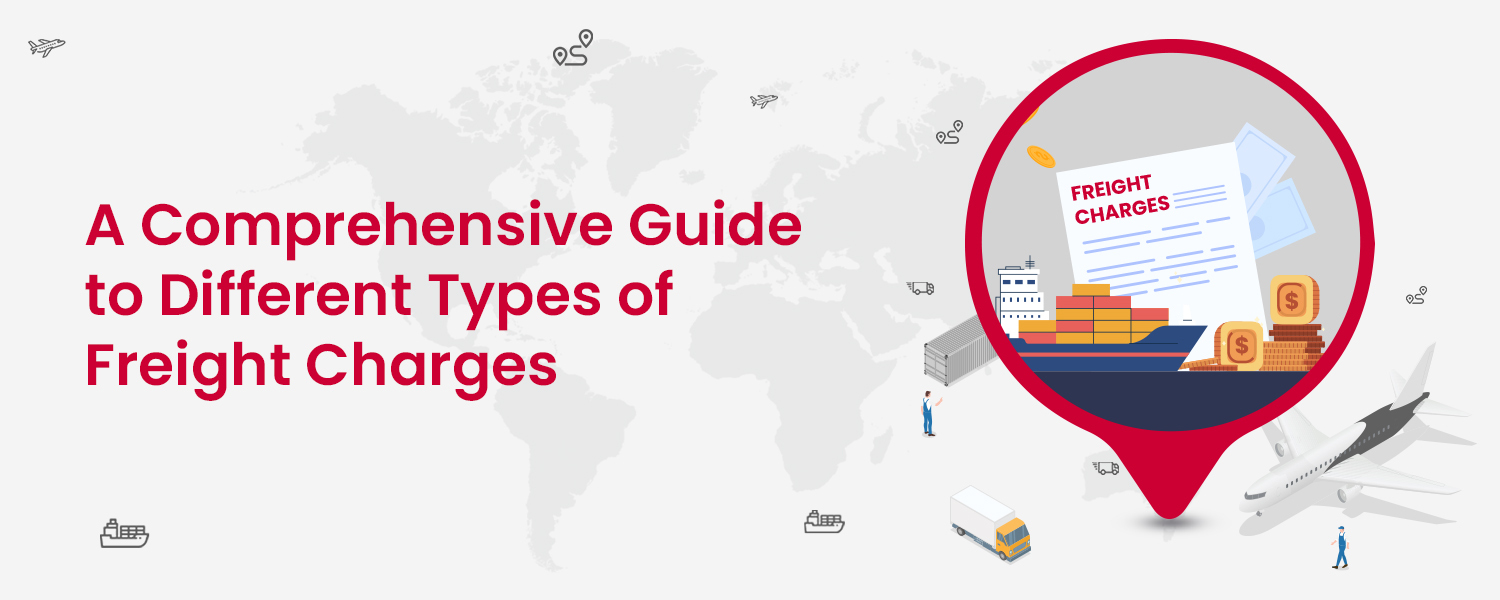Freight charges can be the villain in your business, lurking in the background to sabotage your freight distribution management, or they can be the helping hands, boosting your bottom line when managed effectively. Understanding freight charges isn’t just a matter of cost; it’s about optimizing your entire supply chain management to deliver better service and enhanced customer value. This guide will peel back the layers of this complex topic, from its definition to its types, complete with real-world examples to help you navigate numbers and terms more skillfully.
What are Freight Charges?
Freight charges are the fees for transporting goods from Point A to Point B. They are like the ticket price for your products to reach their final destination, from your warehouse to a distribution centre or directly to the customer’s doorstep.
However, these aren’t just monolithic, one-size-fits-all fees. Freight charges come in various shapes and sizes, influenced by various factors such as weight, dimensions, distance, mode of transport, and any extra services like tracking or insurance that you might opt for.
Understanding freight charges also allows you to take advantage of various shipping options tailored to your needs, such as less-than-truckload or heavyweight shipping. For eCommerce businesses, freight charges are particularly vital. They directly impact your product pricing and competitiveness in the market.
Different Types of Freight Charges
Types of Ocean Freight Charges
As an international trader, understanding these charges is crucial for any business importing or exporting goods via sea.
Freight Category Charges
Ocean Freight (OCE)
The cornerstone of your sea shipping, Ocean Freight, often abbreviated as OCE, is the base charge for transporting a container from Point A to Point B. Think of it as the ticket fare, generally calculated as per TEU (Twenty-foot Equivalent Unit).
Bunker Adjustment Factor (BAF)
The Bunker Adjustment Factor (BAF) is a surcharge imposed to offset changes in the price of the ship’s fuel. BAF changes seasonally and may also depend on geopolitical factors that affect oil prices.
Currency Adjustment Factor
The Currency Adjustment Factor, or CAF, protects shipping companies from foreign exchange risks. It’s a percentage surcharge over the basic ocean freight, providing a cushion against currency volatility.
Interim Fuel Participation (IFP)
Much like BAF, Interim Fuel Participation (IFP) is an additional surcharge applied when there’s a sudden spike in fuel prices. Unlike BAF, which is relatively stable, IFP is a quick-response mechanism to rapidly changing conditions.
Origin Fuel Surcharge (OFUE)
The Origin Fuel Surcharge, often listed as OFUE, is a charge applied by source countries based on their local oil prices. This fee is typically a percentage of the basic ocean freight and comes into play at the initial stage of the shipping process.
Origin Terminal Handling Charges (OTHC)
Origin Terminal Handling Charges (OTHC) cover the cost of services like loading, unloading, and staging your container at the origin port.
Congestion Surcharge (CON)
Congestion Surcharge, denoted as CON, compensates for delays due to high traffic at the ports. If your goods are headed to or coming from a busy port, expect this extra charge to pop up in your freight invoice.
Emergency Risk Surcharge (ERS)
This fee covers additional insurance, added security measures, and potentially higher bunker costs.
Heavy Lift (HEA)
This is a unique charge for cargo that exceeds standard weight limitations and requires specialised handling.
Out of Gauge Surcharge (OOG)
This charge compensates for the loss of space as these oversized containers take up more than their fair share of room on the vessel.
Peak Season Surcharge (PSS)
Shipping companies impose a Peak Season Surcharge (PSS) during high-volume times to deal with the increased operational burden. If you’re shipping during the holiday or harvest, be prepared for this extra fee.
Special Equipment Surcharge (SPE)
If your cargo requires special conditions, like temperature control, the Special Equipment Surcharge (SPE) will apply. This fee covers the cost of using specialized containers or equipment.
Hazardous Surcharge (HAZ)
For the adrenaline junkies of shipping—think chemicals, flammable material, etc.—there’s the Hazardous Surcharge (HAZ). This mandatory charge comes with strict guidelines for handling and shipping potentially dangerous goods.
Suez Canal Surcharge (SUE)
The Suez Canal Surcharge (SUE) applies to all cargo that passes through this critical trade route. It’s a cost built into the architecture of global shipping.
Low Sulphur Charge (LSC)
This surcharge is applied for ships that operate within European Union areas and are required to use low-sulfur fuel, adhering to environmental guidelines.
Panama Canal Surcharge (PCC)
The Panama Canal is another key cog in the global trade machine, and, of course, it has its fee— the Panama Canal Surcharge (PCC). If your shipping route includes a pit stop through this canal, this charge will inevitably appear on your invoice.
Aden Gulf Surcharge (ADE)
The Aden Gulf Surcharge (ADE) is applied to mitigate the potential costs associated with shipping through the Gulf of Yemen. It’s another line item on the bill that buys peace of mind.
FOB Category Charges
Collection Fee (COL)
The Collection Fee covers the costs of collecting your cargo from its origin and moving it to the shipping terminal. Many variables, such as distance, accessibility, and volume, can affect this charge.
Customs Entry (CUS)
This fee accounts for the processing of essential customs documentation and the clearance of your goods through immigration-like checkpoints.
Shipping Line Bill of Lading (BIL)
Issued by the shipping line, the fee for the Bill of Lading document varies depending on the shipping company’s policies and the complexity of your cargo. It’s one document you’ll want to read as diligently as possible.
Cargo Data Declaration (CDD)
The Cargo Data Declaration (CDD) is an EU-specific regulation equivalent to a background check for your goods to identify potential security threats. Various factors, such as the type of cargo and the particularities of the receiving EU country, can influence the charge for this declaration.
Demurrage Charges (DEM)
While we all wish for smooth sailing, there are times when delays are unavoidable—whether it’s a hold-up in unloading or even long customs checks. Such delays can accumulate what are known as Demurrage Charges (DEM).
Load, Lash, and Secure (LLS)
Last but not least, let’s talk about ensuring your precious cargo is tucked in snugly for its ocean voyage. Load, Lash, and Secure (LLS) is the professionally rendered service for securing your cargo inside the shipping container or directly onto the vessel for non-containerized items. The LLS fee can differ based on the type of cargo you’re shipping, its weight, and the special requirements for securing it.
Demystifying DDU Category Charges
Destination Fuel Surcharge (DFUE)
The Destination Fuel Surcharge, or DFUE, is applied at the destination and is directly tied to fluctuating global oil prices. Budgeting for this is crucial to avoid any last-minute navigational errors in your overall cost projections.
High Cube Additional (HQA)
Is your cargo taller than average, or do you need extra-large packages? If so, you might require a ‘high cube’ container, offering you extra vertical space. A high Cube Additional (HQA) fee is an extra charge for these speciality containers that can seriously add up, especially for bulkier cargo that doesn’t conform to standard dimensions.
Container Cleaning/Fumigation Fees
To ensure your cargo meets the health and sanitary regulations of the destination country, you may incur Container Cleaning or Fumigation Fees.
Chassis Fee (CHF)
The Chassis Fee (CHF) covers the essential equipment cost. These fees can vary depending on the logistics company and the distance involved, so check in advance.
Wharfage (WHA)
This fee is essentially the rent you pay for occupying space at the destination port.
On Carriage (ONC)
Carriage (ONC) charges cover the inland movement of your cargo post-unloading.
Telex Electronic Cargo Release Fee
The Telex Electronic Cargo Release Fee applies to creating and sending digital documentation to release your cargo at the destination port.
Destination Charges (DES)
The Destination Charges are levied at the destination port and come into play when the container is handed over to either the importer or the final logistics provider.
Types of Air Freight Charges
Fuel Surcharge (FSC)
Airliners consume jet fuel and a lot of it. The Fuel Surcharge (FSC) is a levy that adjusts to seasonal and regional variations in fuel prices. Just like you notice fluctuations at the gas station, fuel prices can change dramatically depending on geopolitics, climate, or other market factors.
Security Surcharge (SSC)
The Security Surcharge (SSC) is an essential fee covering the extra security measures that come with flying goods internationally.
Container Service Charge (CSC)
The Container Service Charge (CSC) covers the costs of storing your cargo at the airport terminal before it embarks on its aerial journey.
Customs Clearance Fees
Customs clearance fees cover the cost of processing your goods through customs at both the point of departure and the point of arrival. This fee often depends on the type of commodity being shipped, its value, and sometimes even its weight.
Associated Trucking Fees
Your cargo may have landed, but it still needs to get from the airport to its final destination. This is where associated trucking fees come into play. These charges cover the cost of moving your cargo from the airport to a warehouse, distribution centre, or directly to the customer.
Airport Screening Fee
Before your cargo even gets near a plane, it needs to pass rigorous safety screenings to ensure it poses no security risks. These inspections are what the airport screening fee covers.
Document Creation Fee
Document creation fees cover the cost of generating essential documents, like the Bill of Lading (BOL), which is a legal document between the shipper and carrier. Without this, your shipment is grounded before it even gets started.
Transport Document Amendment Fee (AMF)
Sometimes, things change, whether it’s the consignor, the details of the cargo, or even the destination. When that happens, you’ll likely incur a Transport Document Amendment Fee (AMF). This fee covers the administrative costs of making these adjustments and reissuing documents.
Gateway Transfer Fee
This fee is applicable when your cargo needs to be transferred to a third party at a ‘gateway’ location. The Gateway Transfer Fee covers the logistical costs involved in such transfers.
Messenger Fee
The Messenger Fee is essentially a courier fee covering the cost of physically sending important documents where they need to go.
Cargo Insurance
Cargo insurance covers these risks and is usually calculated as a percentage of the cargo’s total value. While not a mandatory fee, it’s highly recommended, especially when shipping valuable or delicate goods.
Types of Truck Freight Charges
Truck Freight Rates
Truck freight rates are the base rates for shipping your goods. These freight rates are heavily influenced by supply and demand dynamics and truck availability.
Pickup Charges
Pickup charges are the fees for collecting your consignment from your premises. Typically, this charge is influenced by factors such as the distance between the pick-up location and the loading point and the time needed.
Handling Charges
These fees cover the labor costs involved in properly stowing your shipment in the truck, keeping in mind factors like weight distribution and ease of unloading.
Main Leg Charges
Main leg charges cover the actual costs of transporting your goods from point A to point B. This includes not just fuel but also tolls, taxes, and any regulatory fees that may apply on the route.
Delivery Charges
Delivery charges cover the costs associated with unloading and handling your consignment before it reaches its final delivery point. This could include moving it to a storage facility or directly to a retail outlet.
Case Study: The Suez Canal Blockage and SUE Charges
You’re an electronics manufacturer, and a significant part of your supply chain model depends on goods coming through the Suez Canal. When the infamous blockage occurred in 2021, Suez Canal Surcharge (SUE) soared overnight. If you weren’t aware of how the SUE could impact your costs, you would have found yourself grappling with inflated charges, disrupted logistics, and perhaps even renegotiating terms with clients. In this case, understanding the role of the SUE in global shipping could have led to alternative plans, such as rerouting through different channels or temporarily leaning on air freight, despite its higher costs.
Conclusion
Understanding the components of freight charges and the nuts and bolts of getting your product from A to B helps you lower the shipping rates. And you must know that 74% of shoppers abandon their carts due to high shipping costs, making freight charges even more crucial.
Converting freight charges as an asset for the business might be easy for big companies and eCommerce businesses but small online businesses fail to do so because of the lack of expertise. That’s why small eCommerce businesses and online stores should partner with third-party logistics providers to handle complex logistics events. These companies are experts in their areas from freight forwarding to customs and last-mile delivery. They can handle everything effectively and at a reasonable cost.
Check out NimbusPost to find the best third-party logistics provider and with our advanced shipping rate calculator, you’ve got the convenience of calculating freight charges at your disposal.
FAQs
How are freight charges calculated?
Freight charges are calculated based on various factors such as the mode of transportation (ocean, air, or truck), weight and dimensions of the cargo, distance between the origin and destination, and any additional services or surcharges required.
Who pays freight charges?
In FOB (Free on Board), the seller pays for transportation to the port, while the buyer covers ocean freight charges. In DDU (Delivered Duty Unpaid), the seller pays for all freight charges except for import duties. Understanding the specific term used is crucial for determining who pays for what in the shipping process.
What is GST on freight charges?
GST on freight charges refers to the Goods and Services Tax applied to the cost of transporting goods. This is considered a supply of services, making the transport company liable for paying the tax. The applicable GST rate for both intrastate and interstate freight charges is 5%.
How much is freight per kg?
The cost of freight per kilogram has been updated to range from approximately $4 to $8 per kilogram. It’s crucial to note that these figures are general estimates, and actual costs may vary depending on the size, weight, and nature of the shipment.
What is the difference between freight and delivery?
Freight refers to the large-scale transportation of goods, often over long distances, using modes like trucks, vans, or trains. It’s commonly associated with bulk shipments and the movement of products between cities or even countries. Delivery, on the other hand, focuses on the final leg of transportation, bringing goods to a specific destination or end-user.
What is the difference between freight and transport?
Freight specifically refers to the goods being moved, and it usually involves comprehensive services like loading, unloading, and delivery. Transport, on the other hand, is a broader term that simply denotes the act of moving goods or people from one place to another and can include various modes like trucks, ships, aeroplanes, and even public transit.




